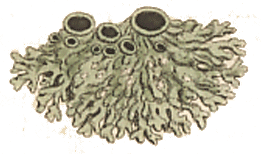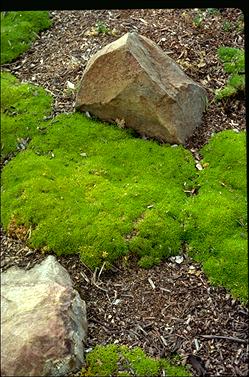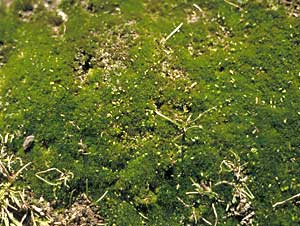
What is a bryophyte?
What's not a bryophyte?
There are various organisms that people mistake for bryophytes. There are two major reasons for this confusion.
One reason is that people often tend to think of anything small and greenish as "mossy". There are various small flowering plants that you might mistake for bryophytes, especially if you see no flowers or if the flowers insignificant. Look at the following pair of photos. On the left is a colony of Scleranthus biflorus, a flowering plant that grows in very low mats or cushions. If you see it while out walking and don't look more closely you might think of it as a colony of moss. After all, various mosses grow in quite compact mats or cushions and on the right is a colony of the moss Campylopus clavatus. Suppose you kneel down to look at Scleranthus and see it in flower ![]() . Would you recognize these as flowers? The flowers at the tops of the short stalks are about three millimetres long. Or would you think of them as the spore capsules on a moss?
. Would you recognize these as flowers? The flowers at the tops of the short stalks are about three millimetres long. Or would you think of them as the spore capsules on a moss?
 |
Left: Scleranthus biflorus, flowering plant Above: Campylopus clavatus, moss |
Bryophytes belong to a large group of organisms known as cryptogams. Other examples of cryptogams are lichens, fungi, algae, cyanobacteria and ferns. All these organisms produce spores rather than seeds. Mostly, the organisms that people mistake for mosses are some of the OTHER CRYPTOGAMS.
The other reason for mistaking some non-bryophytes for bryophytes is that the word "moss" is used in the names of organisms that are not mosses, not even bryophytes in fact. For example, the mossy rocks you can see for sale in many garden centres are mostly covered in lichens! So, WHEN IS A "MOSS" NOT A MOSS? Follow the link to find out.
![An Australian Government Initiative [logo]](/images/austgovt_brown_90px.gif)


